Today Lucia began her day by meeting with an official named Marlene Blanco at the National Police Department who she met on a previous delegation and managed to make a plan to begin facilitating the program for the whole police academy! Marlene used to be the head of the police department and was recently reassigned to head of community outreach. It’s not clear why this change happened, but we hope to continue our positive working relationship with her. In her new position she is still fighting to help us reach our goal of making the Hombres Contra Feminicidio program a requirement for the academy.
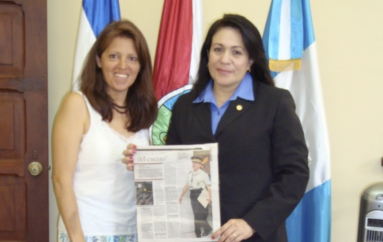
Lucia Muñoz and Marlene Blanco
Later, Lucia and I went to the Ministry of Education (Mineduc) which is in Zone 10 and spoke with their director in the hopes that we would be able to put the program in the national curriculum. Lucia had attempted to meet with them on previous delegations, but was given the run-around. However, she then met the first lady of Guatemala, Sandra Torres Casanova de Colom, who liked the program and was able to open that door for MIA. This time Mineduc was much more attentive to us, but basically said that the current school curriculum already has what we are trying to include. This put Lucia and me in a tight spot because in order to explain what we were really trying to do (which is promote equality and the empowerment of women, make clear the difference between sex and gender, and make men responsible for their actions as well as call for them to actively participate in the movement against gender violence) we might appear too radical. Instead Lucia opted to take home the current curriculum in order to identify how to frame what we have as something they are clearly lacking.
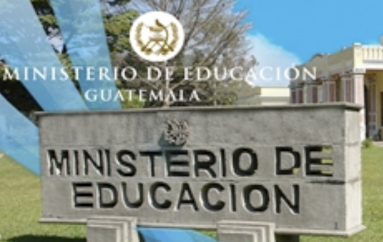
Ministry of Education
“Hombres Contra Feminicidio” as a campaign may sound like something that everyone can agree with, but the concepts that we are teaching are a threat to people who do not want women’s equality and do not agree with changing the “traditional” gendered spheres and roles. Feminicidio (feminicide), to my understanding is the same thing as femicidio (femicide) which is the killing of women for being women, but with the added element of impunity which also exists for gendered reasons. The program is an adaptation of the White Ribbon Campaign, a program which began in Canada in 1991 due to a massacre of women at the hands of a man at the École Polytechnique college in 1989. After speaking with the director of Mineduc and receiving the curriculum, she referred us to the director of a program for family education and community strengthening through education about things such as health, hygiene, and family values. The head of this program, Dirección General de Fortalecimiento de la Comunidad Educativa (DIGEFOCE), was much more receptive to our proposed program and agreed to meet again to discuss working together.
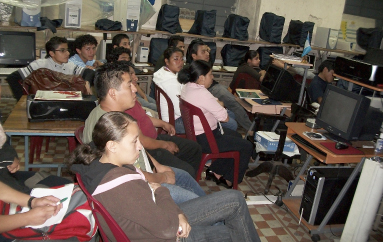
We spoke to the students in the computer lab so we could utilize the projector for the film
We left happily and were off to the night school that CalDH helped us get into, Instituto Central Para Varones. This school is important because its students played a huge role in the student movement during the 36 year internal conflict. Although we are going to this historic school, we are actually presenting to the students who come at night when the school is called Instituto Normal Mixto Nocturno. At night, the school is gender integrated and very diverse because many of the students who attend do so because they have to work in the daytime.
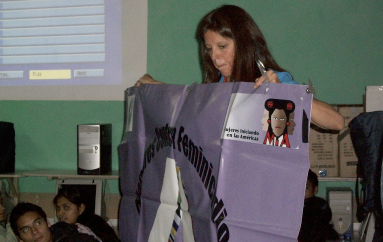
Lucia presenting MIA and MIA’s Campaign, “Hombres Contra Feminicidio”
Lucia and Simon introduced the program to the students and showed a short film about women’s vs. men’s work to make clear that women do a disproportionate amount of work. The students were very curious and interested in the ideas we were presenting. Their ages ranged from 15 to about 45, so there was a wide range of points of view and ideas about gender based on personal experience.
Tomorrow is an early day; we are meeting at 5:30am to head over to Zone 18 to do workshops for the students at la Escuela Oficial Rural Mixta Santa Barbara. For me, seeing the young kids “getting gender” is the most fun because I picture them growing up knowing that women and men are equally deserving of rights. What a beautiful thought.
– Marina Wood is a recent graduate of the Women’s Studies program at Cal State University Long Beach. She has been volunteering with MIA since 2007 and is interning in Guatemala as a facilitator for the “Hombres Contra Feminicidio” campaign for 10 weeks. Marina has been involved in the struggle to end oppressions since her first protest in 2002 against the Afghanistan War and plans to continue learning, educating, and fighting for human rights until the violence stops. The issues closest to her heart are sexual assault and femicide prevention and amnesty for migrant persons in the U.S.






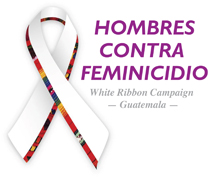
 After meeting with IUMUSAC we ran all around and ended up at Centro de Acción Legal en Derechos Humanos or
After meeting with IUMUSAC we ran all around and ended up at Centro de Acción Legal en Derechos Humanos or 
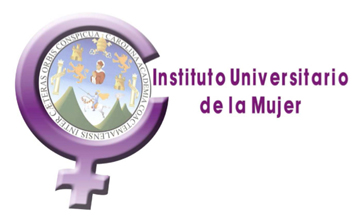


 Proud Founder Member of the Guatemala Peace and Development Network
Proud Founder Member of the Guatemala Peace and Development Network